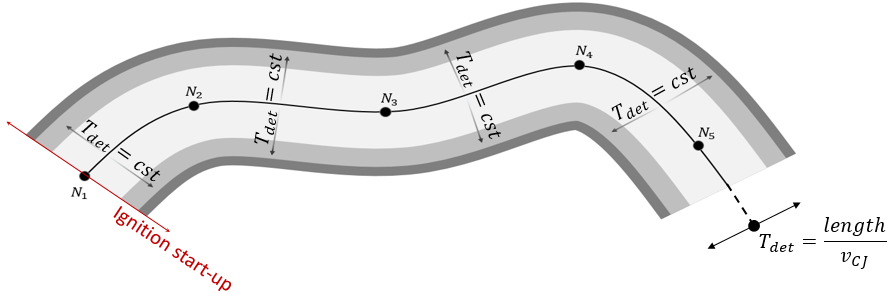/DFS/DETCORD
Block Format Keyword Set burning times of explosive material elements along a neutral fiber of detonating cord. Neutral fiber is provided with an ordered group of nodes and numerically built by spline interpolation.

Figure 1.
Format
| (1) | (2) | (3) | (4) | (5) | (6) | (7) | (8) | (9) | (10) |
|---|---|---|---|---|---|---|---|---|---|
| /DFS/DETCORD/detcord_ID/unit_ID | |||||||||
| VDET | TDET | Iopt | mat_ID | grnod_ID | |||||
Definitions
| Field | Contents | SI Unit Example |
|---|---|---|
| detcord_ID | Detonator
identifier (Integer, maximum 10 digits) |
|
| unit_ID | Unit Identifier (Integer, maximum 10 digits) |
|
| VDET | (Optional) Detonation velocity.
(Real) |
|
| TDET | Detonation time. Default = 0.0 (Real) |
|
| Iopt | (Optional) Formulation flag.
(Integer) |
|
| mat_ID | Explosive identifier.
(Integer) |
|
| grnod_ID | Ordered node group
identifier. Must use
/GRNOD/NODENS. (Integer) |
Example (TNT)
#---1----|----2----|----3----|----4----|----5----|----6----|----7----|----8----|----9----|---10----|
/DFS/DETCORD/11
# VDET TDET Iopt MatID GrNodID
1.0 10.0 0 55 21
#---1----|----2----|----3----|----4----|----5----|----6----|----7----|----8----|----9----|---10----|
/MAT/JWL/55
TNT - data from example 46 with unit: (g-mm-mus) - Standard JWL , No Afterburning
# RHO_I
1.63
# A B R1 R2 OMEGA
3.7121 .0323 4.15 .95 .3
# D P_CJ E0 Eadd I_BFRAC Q_OPT
.693 .21 .07 0 0 0
# P0 Psh
0 0
#---1----|----2----|----3----|----4----|----5----|----6----|----7----|----8----|----9----|---10----|
/EULER/MAT/55
# Flrd
0.0
#---1----|----2----|----3----|----4----|----5----|----6----|----7----|----8----|----9----|---10----|
#enddataComments
- Catmull-Rom Spline interpolation 1 is used to build the neutral fiber with the provided group of nodes. Centripetal-Catmull-Rom method 2 is chosen because it has several desirable mathematical properties: it prevents from loops, self-intersections, cups, and it follows control points more tightly. 3
- Ignition starts from the cord section which contains the first node and is propagated along the neutral fiber. Each section of the cord is supposed to have the same ignition time depending on its position along the neutral fiber. For each element, centroid is projected on neutral fiber and ignition time is deduced from position along neutral fiber.
- Detonation times are available in the Starter output file (IPRI ≥ 3).
- Burn fractions are available in time history file with /TH/BRIC card and the BFRAC contour output keyword.
- Detonation velocity is taken from the JWL material law. Cord detonation is instantaneous.